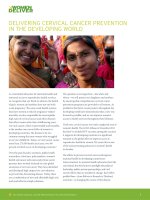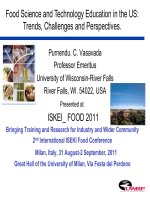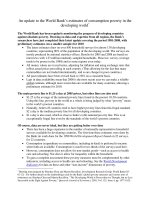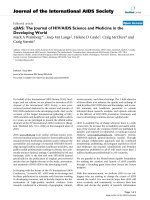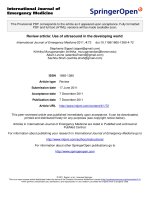Food Security and Environmental Quality in the Developing World - Part 6 (end) pps
Bạn đang xem bản rút gọn của tài liệu. Xem và tải ngay bản đầy đủ của tài liệu tại đây (51.21 KB, 7 trang )
© 2003 by CRC Press LLC
Part Six
Issues and Priorities
© 2003 by CRC Press LLC
Reconciling Food Security
with Environmental
Quality in
the 21st Century
Norman Uphoff
Food security and environmental quality go to the heart of the human condition.
What could be more real than the hunger that gnaws at and heightens the misery of
people who lack minimum daily caloric and nutrient intakes? What could be more
visibly distressing than landscapes that have been robbed of their potential produc
-
tivity by deforestation and soil erosion? What could be more wretched than foul
water and polluted air that make drinking and breathing deadly?
The principal subjects of this volume are of immense importance to humankind.
They are urgent matters in India, as contributions to this volume have shown, but
they are also matters for the whole world to take seriously as we embark upon a
new century. Already, millions of people suffer as a result of uncertain food supplies
and degraded environmental quality, and there is no guarantee that the situation will
get better during the coming decades.
Both food security and environmental quality are creations of the mind, abstrac-
tions that have been produced to enable analysts and policy makers to get a grasp
on these immense challenges. We must take care not to conflate the real terms of
these subjects with their analytical constructions — the latter are important, but they
are only tools. They are a means to the end of assuring that all people will have
access to healthy and sufficient food and will live in an environment that is healthy
and robust.
After two decades of debate and refinement, food security is an idea whose time
has come. It is on the lips and in the writings of agricultural scientists, social scientists
and nutritionists as well as administrators, policy makers and policy critics. The
concept was initially formulated by economists as a challenge to the proponents of
“food self-sufficiency,” who argued that countries needed to be able to produce
enough food to feed their respective populations and that even communities and
households should strive for self sufficiency.
The principles of comparative advantage argue strongly against such a view, as
a less efficient way to satisfy people’s food needs. The self-sufficiency approach
accepts, to varying degrees, an autarkic world in which there is no trade, whether
31
© 2003 by CRC Press LLC
among households, communities, regions or nations. Because it is distrustful of the
mechanisms and terms of trade, it is willing to forgo the production gains posited
from a free-trade solution, considering that these are unlikely to benefit those most
in need of food anyway.
The debate over free trade and the amount and distribution of its benefits is
heating up, with many controversies now raging over the World Trade Organization
and the open-markets regime it supports. Most professional and policy opinion,
certainly among economists, favors a free-trade solution based on efficiency con
-
siderations. Others are less persuaded, and some are flatly opposed because of equity
concerns and possible environmental effects. But what is remarkable is that all agree
on the desirability and need to assure that food security, regardless of the policy and
trade regime endorsed.
Food security, which started as an analytical concept and policy initiative, has
become widely accepted as a human right, although many would argue that it is
often honored in the breach, as are so many other human rights. Around the world,
thousands of person-years are devoted to finding ways to combine supply and
demand factors, augmented by logistical and storage facilities, income supplements,
nutrition education, food fortification and so forth. Their goal is to assure that as
many people as possible consume sufficient calories and nutrients each day to attain
at least the basic level of nutrition needed for living, and hopefully, for good health
and successful livelihoods.
This ex ante perspective on food security has informed most of the contributions
to this volume. How can we understand food demand and supply dynamics suffi
-
ciently to make appropriate interventions that utilize the natural-resource base, the
human resources for work and management and the stock of capital, knowledge and
technology to best advantage? This is not just a matter of supply. It can also be a
matter of assuring that needs are met, whether they can be expressed as effective
demand with monetary backing or not.
The test of success is ex post accomplishment of food security, the extent to
which all persons obtain the food needed for a healthy and productive life. This is
not simply a result of production. It also requires appropriate distribution and utili
-
zation of food, including considerations of equitable access and bioavailability. To
ensure full and sustainable food security, it is necessary to understand the operation
of the entire food system.
*
This includes everything from the genetics of plant and
animal food sources to the biochemistry of nutrient absorption in the body, soil
fertility, cropping systems, harvesting and storage, marketing, food preparation and
cultural influences on diet. The purpose of agricultural processes is to produce
healthy people, not just food.
In this volume, contributors have reviewed the overall likely levels and interac-
tions of food supply and demand, and considered how population growth will affect
the latter. How population growth affects supply will be, at least in part, mediated
by environmental factors, such as how population pressures affect soil degradation,
water availability and the conversion of forested area into arable land. Clearly, food
* Refer to the food systems analysis literature.
© 2003 by CRC Press LLC
security and environmental quality are interdependent, which is why this volume
was framed in this manner.
Environmental quality appears to most to be more concrete, perhaps, than food
security, although it refers to tangible things — soil, water, air, chemicals and
vegetation — the concept and measurement of “quality” is as contingent on defini
-
tions and criteria as is the concept of “security.” There are no absolute standards or
time frames to be employed. Indeed, the units of analysis for “environment” are
generically open systems. One can think of them as nested, in the way that river
basins, watersheds and microwatersheds represent a hierarchy of subsumed units of
biophysical interaction, but there are no natural boundaries for a landscape or an
ecosystem. This means that environmental quality is as much a construct as is food
security. It depends on many definitions and arbitrary measurements that are applied
within systems of incredible complexity, which we understand very incompletely.
In this volume, we look at how efforts to raise agricultural production through
intensified cropping systems affect environmental dynamics and potentials. With
intensification, not only is there more pressure on land and water resources, affecting
their quality, but pest and disease problems become more likely, requiring counter
-
measures that themselves have reduced environmental quality in the past. As con-
sumers become more knowledgeable and concerned about health — their own and
that of the environment — there is more need to devise methods of crop protection
that serve both food security and environmental quality objectives.
One area of research that is not well represented in this volume, because it is
an area where the agricultural and biological sciences have not made great invest
-
ments in the past, concerns environmental quality and biodiversity with the soil.
Relatively little is known about soil biota and their role in food production and
environmental services. With new analytical techniques, including DNA analysis,
researchers are starting to probe the hitherto murky processes of microbial ecology
and the plant root–soil interface. In a country like India, where soils have been used
for hundreds and often thousands of years, this biological dimension of food pro
-
duction and environmental productivity is one that we think warrants greatly accel-
erated investment in research and experimentation.
At the same time as we seek to advance knowledge at various microlevels, we
need to pay more attention to whole systems, not just to their components. The latter
are difficult enough to understand without having to consider whole sets and com
-
plexes of species and processes. Yet, we are learning that often we cannot really
understand these species of processes very well when they are taken out of their
ecosystem context. The concern with the structure and dynamics of larger systems
that include both biophysical and socioeconomic factors can be justified simply on
scientific grounds — to gain a more adequate understanding of how parts and wholes
really function.
However, there is an even more important reason for looking at systems. We
are concerned with the sustainability of development efforts. If these fail, or if they
even falter, we have many more people dependent on them who will suffer, than a
century ago. Our science and technology have permitted us to build larger and more
complicated systems of production and distribution. They support populations more
than three times larger than 100 years ago. We must take steps to ensure that this
© 2003 by CRC Press LLC
is not a scientific and institutional “house of cards” that we have constructed.
Consequently, “building ecosystem vitality and productivity,” as Richard Harwood
subtitled his chapter in this volume, is crucial, seeking to ensure not only that these
ecosystems sustain their levels of performance, but are immune to degradation and
collapse. Contributors to the fourth section of this book have addressed these
concerns, noting new opportunities that biotechnology, for example, may give us,
while also recognizing the hazards that water scarcity could impose despite our
ever-greater technological sophistication. Some of the solutions for sustainability
may be, indeed, fairly simple.
While the first four sections of the book focus on mostly biophysical matters,
we know that the purpose of agriculture and natural resource management is to
achieve better and more secure lives for the human population, living in consonance
with their environments rather than exploiting them. In the latter two sections,
contributors address problems of poverty alleviation and equity. They look at criteria
for evaluating progress in these areas, and particularly at the contributions that greater
access to capital by the poor can make to poverty alleviation, and at the impacts of
new agricultural technology on women’s opportunities and burdens. Such distribu
-
tional issues are not to be considered as separable consequences of development but
as intrinsic causes of the ways in which development proceeds as well as of how
its benefits are shared — or not.
These distributional dynamics are shaped, or at least greatly influenced, by the
policy and institutional choices made at national and international levels, with the
effects playing out at community, household and individual levels. The analyses in
the last section of the book all agree that the performance of the agricultural sector
— its rate and kinds of growth — will have dominant impacts on food security and
environmental quality, but also on national and international economic success. Thus,
the discussions in this volume are not just “sectoral,” but speak to the welfare of
whole national societies.
In the past 20 years, there has been a disposition in policy circles to choose a
shrinking of the public sector in favor of an expanded private sector. While there
have been some global benefits from this, it should be clear that the success and
productivity of private-sector actors depend not just on their wisdom and hard work,
but also on the framework of policies and investments that public-sector decision
makers have created, by deliberation or by default. In particular, it is important that
what economists call public goods be provided to the economy and, indeed, the
whole society, to function effectively.
Public goods are things like public health and safety, clean air and water, the
legal system and recreational facilities, which are accessible to everyone and whose
use does not materially affect others’ use. These are either costly or impossible for
individuals to provide for themselves, so they are better provided on a broad basis.
In the domains addressed by this volume, agricultural research is a prime example
of public goods. It also, sadly, exemplifies the conclusion of social theorists that
public goods tend to be underinvested in, for a variety of reasons. This leads to
suboptimal satisfaction of human needs. When governments are faced with fiscal
shortfalls, there is even more tendency to contract expenditures for public goods,
but this has the effect of reducing well-being in the short and longer run. Govern
-
© 2003 by CRC Press LLC
ments are not the only source of public goods; non-governmental organizations of
various sorts can provide them, as can businesses. But the latter have little incentive
to do this, given their orientation to maximize private profits.
Policy makers should be aware of this unfortunate trend to underprovide public
goods, especially when budgets are tight, because this only makes bad situations
worse. This is not always easily seen, but it is a fact and it weighs particularly
heavily on the agricultural sector, where producers are widely dispersed and unor
-
ganized and, for the most part. politically marginal.
The messages from this book are intended for a broad and diverse audience in
terms of disciplines, roles and nationalities. They speak particularly to persons in
policy-making or policy-influencing positions, because it is so urgent that those in
responsible, authoritative posts act with clarity and a comprehensive understanding,
not just some partial partisan or professional interests. This is especially true in a
country like India, which is so large and complex. Overlooking any major factor in
the agriculture and natural-resource arenas can have very dire consequences. Can
we neglect water shortages? Can we neglect women? Can we neglect crop protec
-
tion? Can we neglect access to credit?
In a world that was less complex and interdependent, with an India that had
500 million instead of its 1 billion people, there was more margin for error,
more tolerance for disconnects and insularities. The world’s agricultural pro
-
ducers, particularly in India, supported by large cadres of agricultural scientists
and extensionists, have been very successful in improving the global food situ
-
ation, thanks in large part to the new technologies of the Green Revolution. But
this success has been uneven, and it has slowed dramatically in the last 5 to 10
years, as rates of increase have dropped and, in many countries, cereal yields
have stagnated.
Part of the problem rests with policies — unattractive prices for producers,
uncertainty of profitability and return — but we also see erosion of the natural-
resource base, particularly as soil and water decline in quality and also per capita
availability. Some of the natural-resource base is also undercut, as rural-to-urban
migration depletes the stock of human talent in rural areas and endemic poverty
persists. Against this, we see the continuing spread of health and education access,
plus growing expectations of democratic governance supported by the electronic
communication revolution. Thus, there is a growing tension between expectations
and performance that has not been addressed specifically in this volume, but which
contributors know lurks in the background of all their discussions.
As we embark on this 21st century, there are strong currents and pressures for
democratization of public affairs and private life. Nowhere is this stronger than in
India, the world’s largest, though still quite imperfect, democracy. The most visible,
formal hallmark of democracy, multiparty electoral competition, has had difficulty
delivering on its claimed advantage over other systems — recruitment of the most
talented leadership to top offices and generation of innovative and appropriate policy
alternatives. This is true around the world, not just in South Asia, where such
shortcomings have very high costs for society.
As yet, there are not good mechanisms for assuring that governments will
proceed with as much knowledge and accountability as people expect. This volume
© 2003 by CRC Press LLC
has not gone into the realm of governance, but we recognize that this is fundamental
both to formulating better policies and to implementing them successfully. What we
have been able to do is examine the domains of and interactions among agricultural
development, natural-resource management, sustainability, social relationships and
policy choices. The analyses and conclusions from a broadly interdisciplinary set
of professionals should give policy makers a better basis for thinking through their
alternatives. We hope that this will be read also by a diverse cross-section of the
public who can formulate clearer thinking about developmental ends and means,
and thereby contribute to a climate of opinion that supports better informed and
more forward-thinking actions, both privately and publicly.

